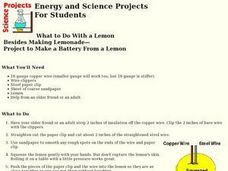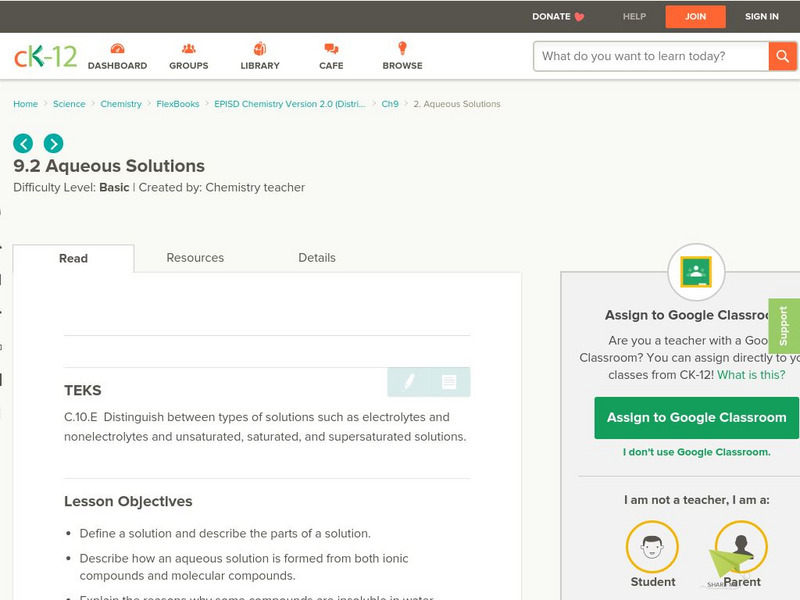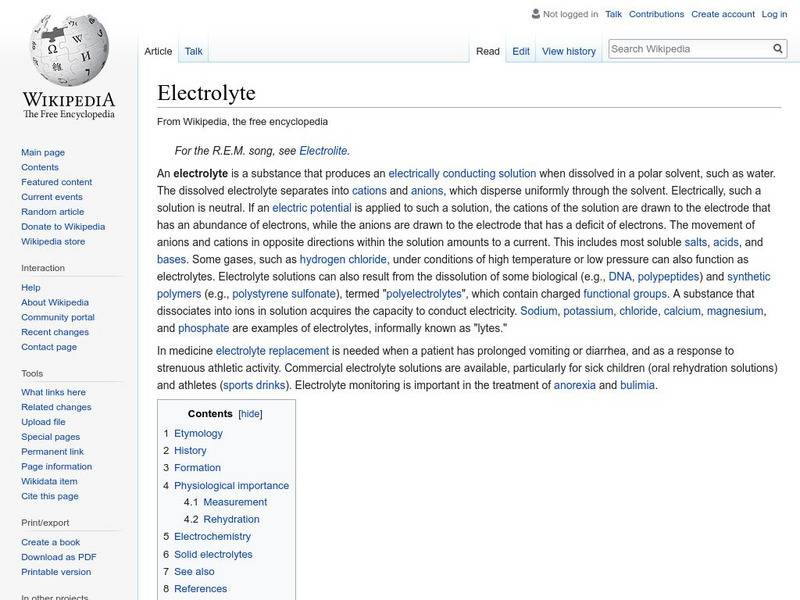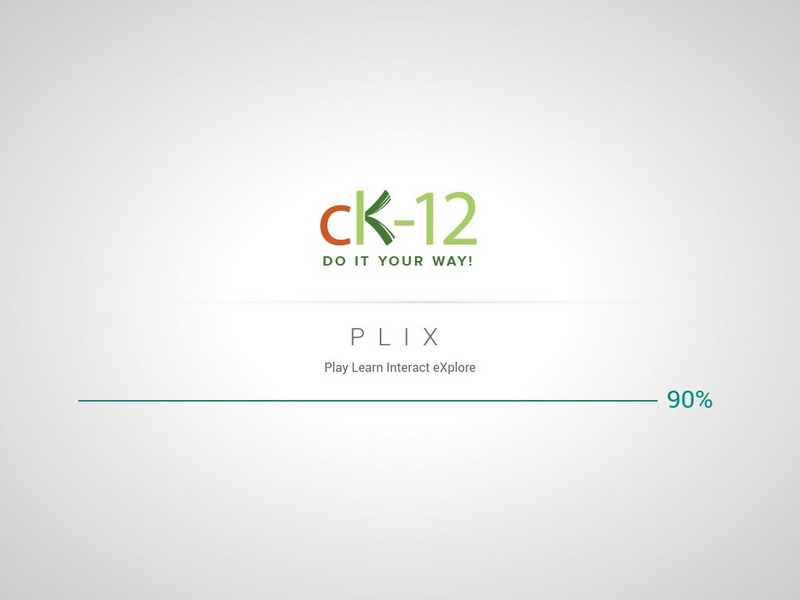Curated OER
Chemical Reactions
In this chemical reactions worksheet, learners solve 16 exercises by writing and balancing chemical reactions. They calculate the concentration of various solutions.
Curated OER
Electrolytic Titration
Students observe an electrolytic titration using a conductivity tester. For this titration lesson, students observe a solution of acid conducting electricity using the conductivity apparatus. They observe the acid solution being titrated...
Curated OER
WS 10.2 Electrolytes and Solubility
In this electrolytes and solubility instructional activity, students answer questions about electrolytes and write balanced equations for the dissociation of salts in water. They also determine solutes that are soluble in water and write...
Curated OER
Lab 23-Follow Up Questions-Conductivity
In this conductivity learning exercise, students answer post lab questions about substances that transferred electrons resulting in electricity flowing through the conductivity leads use to test each substance.
Curated OER
Two-Cell Battery
Students build their own two-cell battery and determine which electrolyte solution is best suited for making a battery. They discuss background information for their experiment, construct and test their battery, and using the chart on...
Curated OER
The Importance of Recycling Batteries
Students discover the types of batteries and their uses. They experience static electricity by rubbing glass jars and using it to raise their hair. After discussing the importance of recycling batteries and using ones that are...
Curated OER
Make a Battery From a Lemon
Fifth graders construct a voltaic battery. They change chemical energy into electrical energy by inserting copper wire into a lemon. They discover the tingle of the wire on their tongue is due to the movement of electrons.
Curated OER
Section 4.2: Ionic and Covalent Bonding
There are only six short answer questions on this assignment. Chemists explain electrical conduction properties of salt, salt water, and gold. They compare ionic and covalent bonds. The explain bond strengths. Perhaps you could use this...
Curated OER
Vocabulary - Solutions
In this solutions worksheet, students use textbooks and dictionaries to find the definitions of 22 terms associated with solutions.
Curated OER
Electrolytes and Colloids Worksheet
For this electrolytes worksheet, students calculate percent composition, determine the electrical conduction of electrolytes, and explain the Tyndall effect. This worksheet has 7 problems to solve.
CK-12 Foundation
Ck 12: Aqueous Solutions
[Free Registration/Login may be required to access all resource tools.] In the following online tutorial students will define a solution and describe the parts of a solution. They will describe how an aqueous solution is formed from both...
CK-12 Foundation
Ck 12: Colligative Properties and Molality
[Free Registration/Login may be required to access all resource tools.] Students distinguish between types of solutions such as electrolytes and nonelectrolytes and unsaturated, saturated, and supersaturated solutions.
TeachEngineering
Teach Engineering: Simple Coulter Counter
Students build and use a very basic Coulter electric sensing zone particle counter to count an unknown number of particles in a sample of "paint" to determine if enough particles per ml of paint exist to meet a quality standard. In a lab...
Texas Instruments
Texas Instruments: Electrolytes: Which Liquid Produces the Most Volts?
In this activity, students' will use a Voltage Sensor to measure the voltage produced by an electrolyte. They will understand that acids and bases are electrolytes and compare voltages of acids to the voltages of bases. Students' will...
Science Education Resource Center at Carleton College
Serc: Conductivity of Water
Students discover that pure water does not conduct electricity and that dissolving different substances in water may or may not cause it to conduct electricity.
Wikimedia
Wikipedia: Electrolyte
This encyclopedia article offers a general overview of electrolytes. Content differentiates the difference in meaning when used in the context of chemistry vs. the context of physiology.
Colorado State University
Colorado State University: The Large Intestine
Gives a description of some of the functions performed by the large intestine. Includes links to more information.
WebMD
Medicine Net: Electrolytes
"What are electrolytes?" Find the answer to this question and read information on potassium, chloride, hyperkalemia, and kidney disease.
Curated OER
Kids Health: Electrolytes
What happens when your blood is tested for electrolytes? Find the answer to this question, and learn how electrolytes, like sodium, potassium, and chloride, function in the body and keep you healthy.
CK-12 Foundation
Ck 12: Chemistry: Strong and Weak Electrolytes
[Free Registration/Login may be required to access all resource tools.] Covers strong and weak electrolytes.
Upper Canada District School Board
Tom Stretton's Advanced Placement Chemistry: Colligative Properties of Solutions
This chemistry e-textbook provides students with AP-level reading and practice material on colligative properties of solutions.
BBC
Bbc: Gcse Bitesize: Electrolysis Aqa
This lesson focuses on Electrolysis, the process by which ionic substances are broken down into simpler substances using electricity. During electrolysis, metals and gases may form at the electrodes. Links are provided to a video and a...
CK-12 Foundation
Ck 12: Plix Series: Electrolytes and Nonelectrolytes
[Free Registration/Login Required] In this interactive activity, change the amount of electrolytes and observe the effect it has on the electrical current to simulate the body's similar function. After the activity, answer one...
Science Struck
Science Struck: Why Do Citrus Fruits Conduct Electricity?
Discover what it is about citrus fruits that enable them to conduct electricity, then make your own citrus fruit battery using the instructions given here.
























